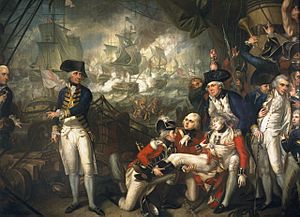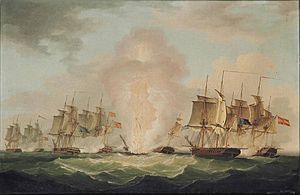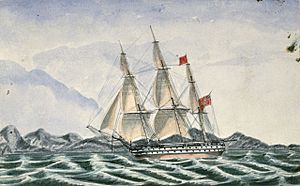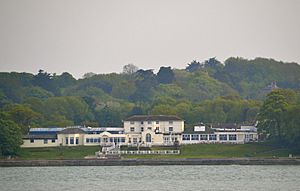Sir Graham Hamond, 2nd Baronet facts for kids
Quick facts for kids
Sir Graham Hamond, Bt
|
|
|---|---|

A very young Midshipman Graham Hamond, shown on the extreme right of this painting by Mather Brown holding a trumpet, during the action on the Glorious First of June
|
|
| Born | 30 December 1779 London, Great Britain |
| Died | 20 December 1862 (aged 82) Yarmouth, Isle of Wight |
| Allegiance | |
| Service/ |
|
| Years of service | 1785–1838 |
| Rank | Admiral of the Fleet |
| Commands held | HMS Echo HMS Champion HMS Lion HMS Blanche HMS Plantagenet HMS Lively HMS Victorious HMS Rivoli HMS Wellesley South America Station |
| Battles/wars | French Revolutionary Wars Napoleonic Wars |
| Awards | Knight Grand Cross of the Order of the Bath |
Sir Graham Eden Hamond (born December 30, 1779 – died December 20, 1862) was a very important officer in the Royal Navy. He became an Admiral of the Fleet, which is the highest rank in the British Navy.
He started his career as a young officer and fought in big battles. These included the Glorious First of June and the Battle of Toulon. Later, he commanded several ships. One of these was HMS Blanche during the Battle of Copenhagen.
During the Napoleonic Wars, Hamond commanded HMS Plantagenet. He captured French ships like Le Courier de Terre Neuve and L'Atalante. He also commanded HMS Lively. With this ship, he helped capture Spanish ships carrying treasure. Later, he commanded HMS Victorious and took part in the attack on Flushing.
After some time away, Hamond commanded HMS Wellesley. He sailed to Brazil with a diplomat to make a trade agreement. He eventually became the Commander-in-Chief of the South American Station.
Contents
Graham Hamond was born in London in 1779. His father, Sir Andrew Hamond, was also a Navy captain. Graham joined the Royal Navy in September 1785 when he was very young. He was listed on his father's ship, HMS Irresistible.
In 1790, he became a midshipman. He served on several ships, including HMS Vanguard and HMS Bedford. In 1793, he moved to HMS Phaeton. He helped capture French ships and earned prize money.
He then joined HMS Queen Charlotte. This was the main ship of Earl Howe. He fought in the Glorious First of June battle in June 1794. After this, he served on HMS Aquilon and HMS Zealous. In 1795, he joined HMS Britannia and fought in the Battle of Toulon.
Becoming an Officer: Promotions and Commands
Hamond was promoted to lieutenant in October 1796. He served in the Mediterranean Squadron. In October 1798, he became a commander. He then took charge of the sloop HMS Echo. His job was to block the port of Le Havre and guide convoys of ships.
In November 1798, he was promoted to captain. He commanded HMS Champion. In June 1799, he captured a French privateer ship called Anacreon. Hamond said Anacreon was "almost a new vessel" and "sails remarkably fast."
He then helped in the Siege of French-held Malta in 1800. Later that year, he commanded HMS Lion. He then took charge of HMS Blanche. With this ship, he fought in the Battle of Copenhagen in April 1801.
Key Battles and Captures
In February 1803, Hamond became commander of HMS Plantagenet. He captured two French ships, Le Courier de Terre Neuve and L'Atalante. This happened during the Napoleonic Wars.
In July 1804, he took command of HMS Lively. He was part of an important event on October 5, 1804. His ship helped capture three Spanish frigates that were full of treasure. HMS Lively also captured two more treasure ships, the San Miguel and the Santa Gertruyda, in December 1804.

In May 1805, he fought against the Spanish ship Glorioso. Then, in November 1805, he transported British troops to Naples. In December 1808, he was given command of HMS Victorious. He took part in the attack on Flushing during the Walcheren Campaign in 1809. This campaign was very difficult for the British.
In May 1813, he commanded HMS Rivoli in the Mediterranean. He received an award, the Companion of the Order of the Bath, in June 1815. He also became a Deputy Lieutenant of the Isle of Wight in 1821.
After a break from the Navy, Hamond commanded HMS Wellesley in March 1824. He then sailed to Brazil with a diplomat named Lord Stuart de Rothesay. Their mission was to negotiate a trade agreement with Emperor Pedro I.

Reaching the Top: Senior Command
Hamond was promoted to rear admiral in May 1825. He traveled on HMS Spartiate to deliver a treaty between Brazil and Portugal to King John VI of Portugal. In September 1828, he inherited his father's title, becoming the 2nd Baronet.
He received another high award, Knight Commander of the Order of the Bath, in September 1831. In September 1834, he became the Commander-in-Chief of the South American Station. His main ship was HMS Spartiate.
He continued to rise through the ranks. He became a vice admiral in January 1837 and a full admiral in January 1847. In July 1855, he received the highest honor, Knight Grand Cross of the Order of the Bath.
In November 1860, he was appointed Rear-Admiral of the United Kingdom. Then, in June 1862, he became Vice-Admiral of the United Kingdom. Finally, on November 10, 1862, he reached the highest rank: Admiral of the Fleet.
Sir Graham Hamond passed away at his home, Norton Lodge, near Yarmouth, Isle of Wight, on December 20, 1862.
Family Life
In December 1806, Graham Hamond married Elizabeth Kimber. They had five children together: three daughters and two sons.


